 |
|
|
| Day 1 |
ARRIVAL IN CAPPADOCIA VIA ISTANBUL
Istanbul is the modern name of the old Constantinople (Byzantium). Upon arrival at Istanbul's Ataturk International Airport, we will meet our guide, who will join us on the brief flight to Nevsehir; a very old Ottoman city in Cappadocia area. Overnight in Cappadocia. |
|
|
|
|
|
|
| Day 2 |
CAPPADOCIA
Welcome to Central Anatolia, where a dozen empires have risen and fallen, as their massive armies moved back and forth across this "land bridge" between Europe and Asia. Cappadocia, with its center in Caesarea (Kayseri), was once the heart of the Hittite Kingdom of the Old Testament. This vast area is one of the most photogenic landscapes in the world. |
|
|
| |
Extraordinary rock formations have become symbolic of this region, where you will enjoy the Valley of the Fairy Chimneys and Goreme's breathtaking Open Air Museum. Watch the potters at their craft, in the famous pottery producing town of Avanos. Finally, savor the natural wonders of the Citadel of Uchisar and Zelve Valley. Overnight in Cappadocia. |
|
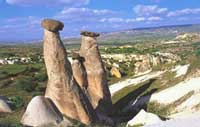 |
|
|
| Day 3 |
KAYMAKLI UNDERGROUND CITY - IHLARA VALLEY - ADANA
In Acts 2:9, pilgrims from Cappadocia were assembled with the thousands in Jerusalem on the Day of Pentecost when they received the initial baptism of the Holy Spirit and heard the Apostle Peter preach his powerful message. We will travel to Cappadocia's scenic Ihlara Valley, where early Christians carved some 3,500 cave churches from the tufa rock. |
|
|
|
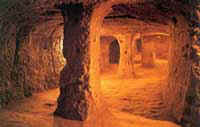 |
|
The beauty and quaintness of these chapels, with numerous wall paintings and Christian symbols, is astonishing. Persecuted Christians - tens of thousands of them - escaping into the earth to flee Arab invaders in the tenth century, tunneled out more than twenty underground cities of refuge here in Cappadocia. Such cities, with carved rooms for kitchens, sleeping |
|
|
|
|
quarters, stables, and chapels for worship, descend five to ten stories into the earth. You will enjoy your own-guided tour to one of the best-preserved underground cities in Cappadocia, the city of Kaymakli. Continue to Adana; the country's fourth largest city. Adana is situated some thirty miles east of Tarsus, birthplace of the St. Paul. Overnight in Adana. |
|
|
| Day 4 |
ANTIOCH - SELEUCIA PIERIA - TITUS TUNNEL
Antioch was the headquarters journeys of St. Paul. It was the third largest city of the Roman Empire, rivaled only by Rome and Alexandria. St. Peter, St. Paul, Barnabas and Timothy all preached in this place where Jesus followers were first called Christians (Acts 11:26). |
|
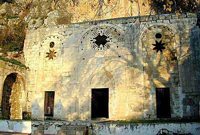 |
|
|
|
|
We will visit the cave where they met in secret where St. Peter first celebrated Mass. South of the church, The Iron Gate was one of the actual entrances of Biblical Antioch; strolling through the old part of the city, you cannot help recalling the saints who walked these old streets, for little has changed since that time. St. Paul and Silas departed from here on the second missionary journey (Acts 15:35-36). Discover the impact of leaders such as Ignatius of Antioch and John Chrysostom. Continue to visit the archaeological remains of Seleucia, the port from which St. Paul, St. Barnabas, and John Mark departed from Antioch on the St. Paul's First Journey (Acts 13:4). Then you will visit an unbelievable Tunnel system carved through the mountains by the emperors Vespasian and Titus. Overnight in Antioch. |
|
|
| Day 5 |
TARSUS - ICONIUM
After breakfast at the hotel, we will drive to Tarsus to visit the St. Paul's well, the Gate of Cleopatra, and the latest excavations. Then depart for Iconium (Today's Konya), where St. Paul preached and encouraged believers during his first missionary journey (Acts 14:1-6). Iconium was once the home of the sect of mystical Muslims called Swirling Dervishes. Overnight in Konya. |
|
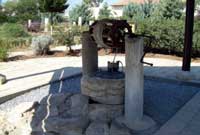 |
|
|
| Day 6 |
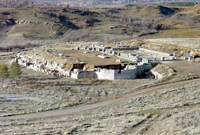 |
|
ANTIOCH OF PISIDIA - COLOSSAE
We will drive to
Pisidian Antioch, where nearly the whole city came to hear St. Paul preach during his first missionary journey
(Acts 13:14-52). The marvelous excavations include the ancient
church and the great first-century Temple of Augustus. Today, we
will travel the Royal Road that once connected Ephesus
with |
|
|
|
|
distant Babylon. Visit the unexcavated site of ancient Colossae by the village of Honaz. The St. Paul wrote one of his prison epistles to the church at Colossae, a city situated on the Lycus River. Overnight in Pamukkale. |
|
|
| Day 7 |
HIERAPOLIS - LAODICEA
At Hierapolis (Pamukkale), enjoy the "Cotton Castles" of brilliant white calcium rock formations and hot-water travertines, where hot mineral waters emerge from the earth and cascade over cliffs. As the water cools, the calcium precipitates and clings to the cliffs, forming snowy white travertines (waterfalls of white stone), which give credence to the name Pamukkale, which means "cotton castle", from the two words "pamuk" (cotton) and "kale" (castle). |
|
|
| |
|
The travertines form shallow pools supported by colorful stalactites. This enchanting place is one of the natural wonders of Asia Minor. The churches here in Hierapolis, Colossae, and Laodicea once flourished under the ministry of Epaphras (Colossians 4:12-13). We will explore incredible excavations at Hierapolis, including a Byzantine church, the Great |
|
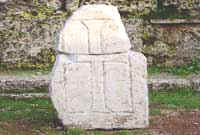 |
|
|
|
|
Theatre, the Temple of Apollo, and the Plutonium, which pagan cults once called "the entrance to hell". Then continue to Laodicea one of the Seven Churches, (Rev. 3: 14-22) were chastised for being lukewarm, "You are neither cold nor hot" (Rev. 3: 15), and for being too comfortable incorporating pagan and Christian beliefs. In the famous scripture from Revelation (3: 20-21), Jesus says to the Laodicean church: "Behold, I stand at the door and knock...". Today, there are many acres of ruins to see, including the stadium and columned streets and a chance to witness the newest excavations in Laodicea. Dinner and overnight in Kusadasi. |
|
|
| Day 8 |
EPHESUS - MILETOS
Ephesus (Rev. 2:1-7), major port city on the Aegean, was the commercial, political, and religious center of all of Asia Minor. After a lunatic completely burned the Temple of Diana (Artemis) on the night that Alexander the Great was born in 356 B.C., the Ephesians worked for 120 years to complete a magnificent reconstructed temple, one of the Seven Wonders of the ancient world. |
|
|
|
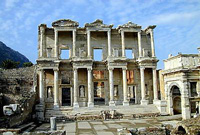 |
|
The city became part of the Roman Empire in the second century B.C. As a Roman capital of Asia Minor, Ephesus boasted a population approaching 250,000 people. The St. Paul's first visit to Ephesus was brief - during his second missionary tour (Acts 18:19-21). His second visit lasted about three years - during his third missionary tour (Acts 19:1 to 20:31). |
|
|
|
|
Luke's account of the worship of Diana appears in Acts 19:34-35. The Great Theatre (stadium) mentioned in Acts 19:29-31 could seat 25,000 people. Walk the marble-paved street with grooves made by chariot wheels. See the Fountain of Trajan, the Library of Celsus, and the Great Theatre. Visit the Chapel of the Virgin Mary (Double Church), where the Third Ancient Council convened. Enjoy St. John's Basilica (built on the site of the St. John's tomb), and ponder the remains of the Temple of Diana. Finally, enjoy a visit to the Ephesus Museum. |
|
|
|
|
Drive to Miletos, home of ancient philosopher Thales (640-546 B.C.), one of the fathers of Greek geometry, astronomy, and philosophy. It was here, in the first Christian century, that the St. Paul, on his third missionary journey, called for the Ephesian elders and preached a powerful message to them (Acts 20:15-38). It was also here that St. Paul left his friend |
|
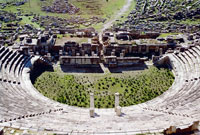 |
|
|
|
|
Trophimus, who was too ill to continue (II Timothy 4:20). As a port at the mouth of the Meander River, Miletos was a natural outlet for Phrygian trade. Like the one at Ephesus, however, Miletos's sea harbor eventually filled with silt, and commerce dwindled. The city's remote quietness makes it special to devout students of Scripture. Its ancient ruins include the marvelous 15,000-seat theatre. Overnight in Kusadasi. |
|
|
| Day 9 |
SARDIS - PHILADELPHIA - SMYRNA
Travel to Sardis, another of the Seven Churches of Revelation. Jesus told Sardis, "I know thy works, that thou hast a name, that thou livest, and art dead"(Rev. 3: 1-6). Coins were minted and the dyeing of wool originated in Sardis. You will be impressed by the massive scale of the Temple of Artemis, by the white marble Royal Road, by the gymnasium, and by the synagogue.
Visit the site of Philadelphia also one of the Seven Churches of Revelation (Rev. 3: 7-13). Christ told those who overcame that He would write upon them "the name of my God, and the name of the city of my God, which is New Jerusalem." (Rev.3: 12) Today, not much is left to mark the spot. You will see an ancient wall and the |
|
|
|
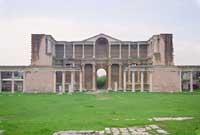 |
|
remains of a Byzantine basilica. Continue to Smyrna; poor and persecuted, the church at Smyrna suffered amidst prosperity for its refusal to worship the Roman Emperor. This proved to be the last stronghold of Christianity in Asia Minor. Home of the great second century Bishop Polycarp who was burned alive at the age of eighty-six. Overnight in Izmir. |
|
|
|
| Day 10 |
THYATIRA - PERGAMUM
Today, we will visit our final two of the Seven Churches of Book of Revelation. At Thyatira
(Rev. 2: 18-28), you
will see the ruins of an ancient commercial center, located in the fertile
valley where the trade route passed. One of the town's cloth and dye
merchants was a woman named Lydia, who conducted |
|
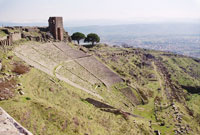 |
|
|
|
|
business as far away as Philippi, where she became the first European convert to Christianity, during St. Paul's second missionary journey (Acts 16:11-15). A most memorable experience will be Pergamum, with its acropolis and Great Theatre, the steepest of the ancient world. Revelation 2:12-16 describes the city as "where Satan's seat is", a reference to the altar of Zeus, where we pause for reflection on the fulfillment of Scripture. Nearby, visit the Red Basilica; once a pagan temple, it later converted into a Christian church. Finally, walk thru the Pergamum Asclepion, the famous medical center of antiquity. Overnight in Ayvalik. |
|
|
|
| Day 11 |
ASSOS - ALEXANDRIA TROAS
Today you begin your tour with Assos where Paul rejoined his companions after walking across the headland on his own and visit the ruins of the city. Then drive to Troas, founded about 300 B.C. by one of the generals of Alexander the Great. During St. Paul's Second Journey, it was from Troas that he received the |
|
|
| |
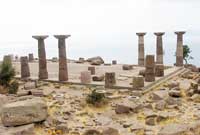 |
|
"Macedonian call" to Europe. This is where Luke's account changes from "they" to "we" (Acts 16:6-12), indicating that he joined St. Paul's team at Troas. Returning from Macedonia during his third journey, St. Paul was in Troas for a week, when the young man Eutychus fell from the third loft as St. Paul preached. Overnight in Canakkale. |
|
|
|
| Day 12 |
NICEA - ISTANBUL
At Nicea, you will see remains of Constantine's palace, now covered by the water at the shore of Lake Iznik. It was here in this palace chapel that the First Ancient Church Council convened in A.D. 325 to produce the Nicene Creed. Enjoy Nicea's St. Sophia Church, where the Seventh Church Council convened in 787. Continue to Istanbul for lunch at the Spice Bazaar. Istanbul, the world's only city that spans two continents, was originally "Byzantium"; it became "Constantinople" in 4th. A.D. |
|
|
| |
|
330, when Emperor Constantine renamed it for himself and built a palace here. It became "Istanbul" in 1453. Experience the unique markets, peddlers, and stalls selling almonds, pistachios, iced drinks, and black coffee - a vigorous anthill of Turkish life. Relax on a Bosphorus cruise on a private boat. Finally, enjoy an orientation drive of the city. |
|
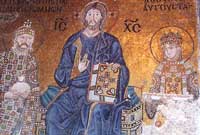 |
|
|
|
| Day 13 |
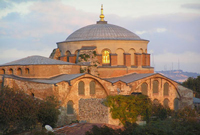 |
|
ISTANBUL
Today's visits begin with Istanbul's Hippodrome, once a stadium with 100,000 seats, where chariot races and circuses often degenerated into violence. Visit the nearby Blue Mosque. The Second Church Council (381) met in the Church of St. Irene, the first church ever built in Istanbul. You will visit the fifteenth-century |
|
|
|
|
Topkapi Palace of the Ottoman Sultans. In the first court of this palace stands the Church of St. Irene, the city's cathedral church until the Church of Hagia Sophia (Holy Wisdom) was completed in 360. After rioters burned both churches to the ground in 532, Emperor Justinian rebuilt them to their present grand scale. Upon entering his newly built Hagia Sophia for the first time, Justinian exclaimed, "Glory to God that I have been judged worthy of such a work. Oh Solomon, I have outdone you!" Enjoy your visit to the Hagia Sophia, where the 5th Church Council met in 553.
For a thousand years, this was the largest church in Christendom. When Mehmet the Conqueror made it a mosque in 1453, he added four minarets (prayer towers). The building has not been used as a mosque since 1935, when it became the Museum of Byzantine Art. The four minarets remain. Conclude your day with a visit to the Grand Bazaar, an ancient covered market of some 4,000 shops. |
|
|
| Day 14 |
ISTANBUL - HOMEBOUND FLIGHT
Memories of these two weeks will last a lifetime. Your own Bible will constantly remind you of the storehouse of riches obtained from these ancient and Biblical sites where you have walked and studied. |
| |
|
| - |
We can design shorter or longer itineraries according to your interest. |
| - |
You may add one day trip to Patmos Island with private boat including the tour of St. John Monastery, The Museum and The Cave of St. John to above program. |
| - |
You may combine above program with any itinerary regarding Israel, Greece and Italy. |
|
|
 |
|
|
|